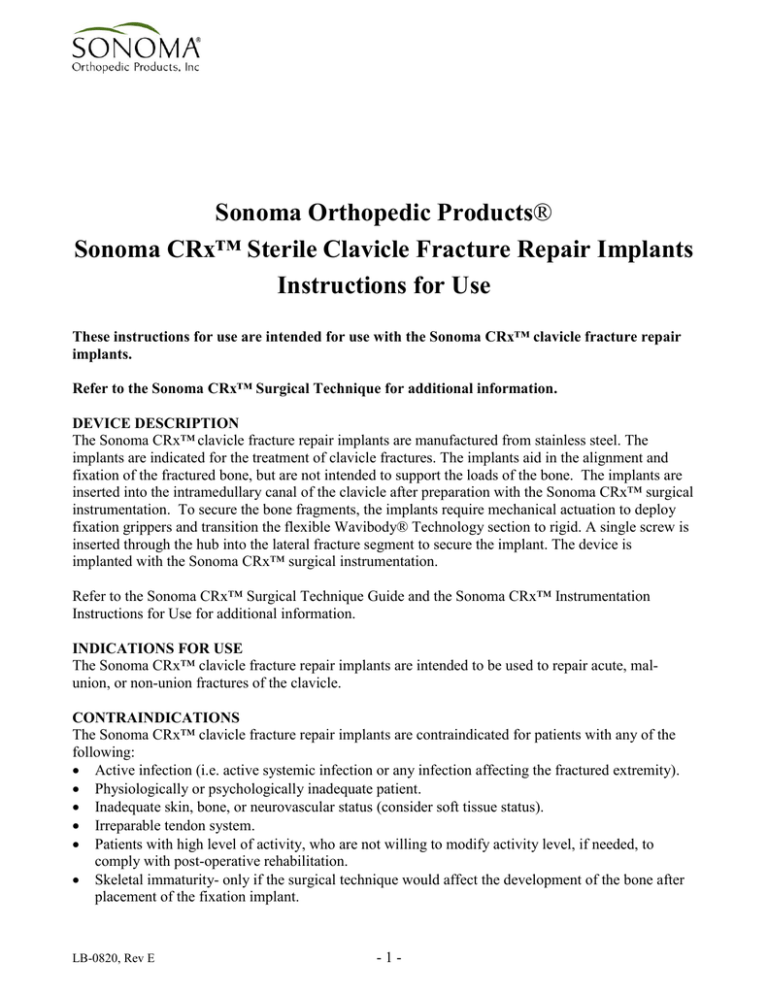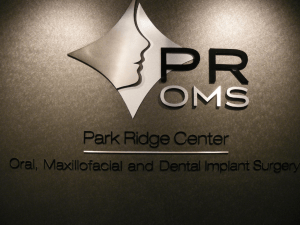
Sonoma Orthopedic Products®
Sonoma CRx™ Sterile Clavicle Fracture Repair Implants
Instructions for Use
These instructions for use are intended for use with the Sonoma CRx™ clavicle fracture repair
implants.
Refer to the Sonoma CRx™ Surgical Technique for additional information.
DEVICE DESCRIPTION
The Sonoma CRx™ clavicle fracture repair implants are manufactured from stainless steel. The
implants are indicated for the treatment of clavicle fractures. The implants aid in the alignment and
fixation of the fractured bone, but are not intended to support the loads of the bone. The implants are
inserted into the intramedullary canal of the clavicle after preparation with the Sonoma CRx™ surgical
instrumentation. To secure the bone fragments, the implants require mechanical actuation to deploy
fixation grippers and transition the flexible Wavibody® Technology section to rigid. A single screw is
inserted through the hub into the lateral fracture segment to secure the implant. The device is
implanted with the Sonoma CRx™ surgical instrumentation.
Refer to the Sonoma CRx™ Surgical Technique Guide and the Sonoma CRx™ Instrumentation
Instructions for Use for additional information.
INDICATIONS FOR USE
The Sonoma CRx™ clavicle fracture repair implants are intended to be used to repair acute, malunion, or non-union fractures of the clavicle.
CONTRAINDICATIONS
The Sonoma CRx™ clavicle fracture repair implants are contraindicated for patients with any of the
following:
Active infection (i.e. active systemic infection or any infection affecting the fractured extremity).
Physiologically or psychologically inadequate patient.
Inadequate skin, bone, or neurovascular status (consider soft tissue status).
Irreparable tendon system.
Patients with high level of activity, who are not willing to modify activity level, if needed, to
comply with post-operative rehabilitation.
Skeletal immaturity- only if the surgical technique would affect the development of the bone after
placement of the fixation implant.
LB-0820, Rev E
-1-
Patients with poor prognosis for healing, e.g. patients with decubitus ulcer, severe protein
deficiency and/or malnutrition.
Patients with uncontrolled diabetes or high blood pressure.
WARNINGS/ PRECAUTIONS
The use of metallic surgical implants has given the surgeon a means of bone fixation and helps
generally in the management of fracture and reconstructive surgery. However, these implants are
intended only to assist healing and not intended to replace normal body structures. Metallic bone
fixation devices are internal splints and aid alignment of the fracture while normal healing occurs. The
size and shape of bones and soft tissue place limitations on the size and strength of implants. If there is
delayed union or nonunion of bone in the presence of weight bearing or load bearing, the implant could
eventually break due to metal fatigue. Therefore, it is important that immobilization of the fracture site
be maintained until firm bony union (confirmed by clinical and radiographic examination) is
established. All metallic surgical implants are subject to repeated stresses in use, even in the absence
of direct weight bearing, which can result in metal fatigue. Factors such as patient’s weight, activity
level, and adherence to weight bearing or load bearing instructions have an effect on the stresses to
which the implant is subjected, and therefore on the life of the implant.
The surgeon must be thoroughly knowledgeable not only in the medical and surgical aspects of the
implant but also must be aware of the mechanical and metallurgical aspects of surgical implants.
Post-operative care is extremely important. The patient must be warned that noncompliance with
post-operative instructions could lead to loosening or breakage of the implant, and/or possibly
migration, requiring revisional surgery.
WARNINGS
1. These warnings do not include all adverse effects that could occur with surgery in general, but are
important considerations particular to metallic internal fixation devices. General surgical risks
should be explained to the patient prior to surgery.
2. The surgeon must be thoroughly familiar with the prosthesis, instruments, and surgical procedure
prior to performing surgery. Proper surgical procedures and techniques are the responsibility of the
medical professional. Each surgeon must evaluate the appropriateness of the procedure based on
personal medical training and experience. Medical procedures for the optimal utilization of the
implant should be determined by the physician.
3. All patients should be adequately warned of the risk associated with the use of this implant and the
surgical technique. Careful review of the technique with the patient should be done prior to
utilizing these prostheses. Additionally, patient’s willingness and/or ability to follow postoperative instructions may impact the surgical outcome.
4. Correct selection of the implant is extremely important. The potential for success of fracture
fixation is increased by the pre-operative planning. The physician must ensure the implant is
appropriate for the patient’s individual anatomy. Placement, positioning, or fixation of the
prosthetic components may result in unusual stress conditions and a subsequent reduction in
service life of the implant. While proper preparation can help minimize risks, the size and shape of
human bones present limitations on the size and strength of implants. Metallic internal fixation
devices cannot withstand activity levels and/or loads equal to those placed on normal healthy bone.
LB-0820, Rev E
-2-
5.
6.
7.
8.
During the healing process, these devices are not designed to withstand the unsupported
stress of full weight bearing or load bearing.
This is a load sharing device which is designed to maintain alignment of a fracture until healing
occurs. If healing is delayed, or does not occur, the implant could eventually break due to metal
fatigue.
Certain degenerative diseases or underlying physiological conditions such as diabetes or
rheumatoid arthritis may alter the healing process, thereby increasing the risk of implant breakage.
Periodic, long-term follow up is recommended to monitor the position and state of the prosthetic
components, as well as the condition of the adjoining bone.
The Sonoma CRx™ implants have not been evaluated for safety and compatibility in the MR
(magnetic resonance) environment. They have not been tested for heating and migration in the MR
environment.
PRECAUTIONS
1. Surgical implants must never be reused. These are single-use devices. An explanted implant
must never be reimplanted. Even though the device appears undamaged, it is neither designed nor
intended for reuse. These devices must not be resterilized or reused after contact with body tissues
or fluids as they have not been validated/verified for multiple uses. Reuse may increase the risk of
infection.
2. Removal after fracture healing. Metallic implants can loosen, fracture, corrode, migrate, cause
pain, or stress shield bone even after a fracture has healed, particularly in young, active patients.
While the surgeon must make the final decision on implant removal, we recommend that whenever
possible and practical for the individual patient, fixation devices may be removed once their
service as an aid to healing is accomplished and within 1 year. Implant removal should be followed
by adequate post-operative management to avoid reincident of the fracture.
3. Adequately instruct the patient. Post-operative care and the patient’s ability and willingness to
follow doctor’s instructions are two of the most important aspects of successful fracture healing.
This is particularly important should the device be used to treat an unstable fracture. The patient
must be made aware of the limitations of the implant and that physical activity and full weight
bearing or load bearing have been implicated in premature loosening, bending, or fracture of
internal fixation devices. The patient should understand that a metallic implant is not as strong as
normal, healthy bone and will fracture under normal weight bearing or load bearing in the absence
of complete bone healing. Mental or physical impairment which compromises or prevents a
patient’s ability to comply with necessary limitations or precautions may place that patient at a
particular risk during post-operative rehabilitation.
4. Consider possibility for conservative treatment.
COMPLICATIONS AND ADVERSE EFFECTS
The risks and complications with this device and the implantation procedure may include:
Nonunion or delayed union of the fracture which can lead to breakage of the implant, or bending,
breakage or separation of the metal component(s) due to other causes;
Fracture of the bone and/or fixation element leading to the need for further surgery;
Loss of anatomical position with rotation, shortening, or angulation.
Loosening of the prosthesis requiring repeat surgery;
Loosening due to inability to stabilize at surgery;
Shortening or misalignment due to compression of the fracture or bone resorption;
LB-0820, Rev E
-3-
Pain, discomfort, or abnormal sensations due to the presence of the implant;
Decrease in bone density;
Necrosis of bone or bone loss possibly resulting in revision or removal;
Vascular change;
Infection requiring revision, possible removal of the implant, or further procedures;
Bleeding requiring transfusions and/or reoperation;
Local blood clots that may cause edema or clots/emboli that move to the vital organs resulting in
further treatments, surgeries or possibly more serious complications such as; heart attack, stroke,
coma or death;
Nerve damage causing pain, numbness and/or tingling;
Misalignment of the implant or bone;
Limited mobility after surgery;
General immobility of the shoulder;
Material sensitivity or allergic reaction to materials of the implant or a foreign body;
Fracture or malfunction of the implant that may or may not lead to serious injury, including
reoperation;
Generation of material debris;
Adverse reaction to anesthesia;
Migration of metal and synthetic wear debris possibly resulting in a bodily response;
Dissimilar metal contact resulting in the release of corrosive by-products;
Fretting resulting in the release of metallic wear debris, possibly leading to pitting and crevice
corrosion;
Subluxation or dislocation of the components and/or bone at the joint;
Tendon rupture or tendonitis.
HANDLING AND STERILIZATION
This product is provided pre-sterilized by radiation for single use only.
SURGICAL TECHNIQUE
Refer to the Sonoma CRx™ Surgical Technique for specific implantation instructions.
CAUTION
DO NOT INSERT IMPLANTS WITH FIXATION GRIPPERS PARTIALLY OR FULLY
DEPLOYED
DO NOT FORCE OR OVERTIGHTEN THE ACTUATION DRIVER
DO NOT FORCE, TWIST, OR STRIKE THE IMPLANT DURING INSERTION.
DO NOT PRY AND /OR TWIST THE IMPLANT IN ORDER TO ALIGN THE FRACTURED
BONES AS THE IMPLANT MAY BECOME DAMAGED AND BENT, RENDERING IT
UNUSABLE
IMPLANT REMOVAL
Use the Sonoma CRx™ Implant Removal Kit and reference the Sonoma CRx™ Implant Removal Kit
Instructions for Use for implant removal.
LB-0820, Rev E
-4-
Caution: Federal (USA) law restricts this device to sale by or on the order of a physician.
Manufacturer:
Sonoma Orthopedic Products, Inc.
3589 Westwind Boulevard
Santa Rosa, CA 95403
Telephone: 707-526-1335 ext. 241
www.sonomaorthopedics.com
MediTech Strategic Consultants B.V.
Maastrichterlaan 127-129
6291 EN Vaals
The Netherlands
Manufacturer
Authorized European Community Representative
Do Not Reuse
Caution, consult accompanying documents
Non-sterile
Catalog Number
Batch code
Sterilized using gamma radiation
LB-0820, Rev E
-5-
Use by date
Contents
By prescription only
OR
Catalog Number
Description
Sonoma P/N: CRx-WG2-40100-S
Sonoma P/N: CRx-WG2-40110-S
Sonoma P/N: CRx-WG2-40120-S
Sonoma P/N: CRx-WG2-40130-S
Syntec P/N: 202810 to 202840
SC27xx
SC27xx-S
4mm x 100mm Sonoma CRx™
4mm x 110mm Sonoma CRx™`
4mm x 120mm Sonoma CRx™
4mm x 130mm Sonoma CRx™
Cortex Screw Self-Tapping Ø2.7mm x Various Lengths
USA Patents 7,846,162, 7,914,533, 7,942,875, 7,909,825, 8,287,539, 8,287,541, and 8,439,917. USA and
International Patents pending.
™Trademarks and ®Registered marks of Sonoma Orthopedic Products, Inc.
©2011 Sonoma Orthopedic Products, Inc. All Rights Reserved.
LB-0820, Rev E
-6-



